Entries tagged with “lead”.
Did you find what you wanted?
Thu 7 Feb 2019
Unfortunately this website has taken a backseat to actual work. My apologies for not updating the information, and especially to trusted subscribers of this site.
In the coming months, I plan to publish more posts with the same type of information. Thanks for hanging on. – Alden
As a preview: Did you notice that the State of Michigan OSHA (MIOSH) has updated (lowered) their lead (Pb) blood level mandates? Sadly, it took a lot of people being overexposed to lead (remember Flint, MI?) in order to make this simple change. I hope other states follow.
Thu 19 May 2016
Posted by admin under Asbestos, Grant, Hazard Communication, hygienist, industrial hygienist, Lead, Leaded Sheetrock, Noise, OSHA, Presentation, Risk, Silica, Training, Uncategorized
Comments Off on Coming soon – Free Video & Training Materials (Health Hazards in Construction)
Exciting news! In just a few months we will be releasing free training materials!
In summary: I applied (and obtained) a grant through OSHA to produce training materials for the four major health hazards in construction. We are titling it, “Focus 4 Health Hazards for Construction”.  (similar to the Focus 4 Susan Harwood training materials available at OSHA)
Indented audience is for younger construction workers in hazard recognition of, 1. silica, 2. noise, 3. asbestos and 4. lead (pb) in construction. A short video (1-4 minutes) for each subject gives an introduction to the hazard. And, to follow up a training power point presentation (and short summary) will also be available to further instruct people in how to control and protect themselves.
On a personal level…it has been exhausting, and I’ve learned a lot!  From obtaining the grant, to hiring a videographer, filming, securing filming sites, and quarterly reports…. exhausting.  But, I’m confident you (and others) will enjoy it. Subscribe (via email) to keep updated. You can also follow me on instagram: “adventuresInIH”. (link coming)
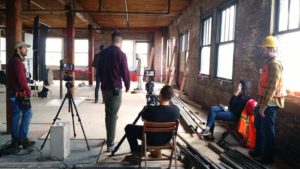
Thu 29 Nov 2012
Posted by admin under Admin Controls, Bio Exposure Index, Biological Monitoring, Engineering Controls, Hazard Communication, industrial hygienist, Lead, Leaded Sheetrock, OSHA, PEL (Perm Exp Limit), Personal Protective Equip (PPE), Respirators, Training
Comments Off on Construction Lead Paint – the basics
Looking back at my lead in construction posts, I realized I did an inadequate job of summarizing why construction activities are dangerous when working with lead.
If you work in construction, here’s are the quick points as to why you should be concerned about lead.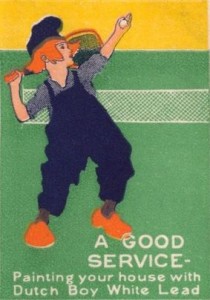
- There has been A LOT of lead added to paint over the years. (it can vary 0.01% to upwards of 20%, and there’s no way to tell by looking)
- The activities we do in construction disturb this paint (some worse than others)
- You can be exposed to paint by inhaling it (if it is airborne), and if you happen to get it on your hands and you eat it (by transfer).
- The real concern is kids. (your kids, the kids who might be there after you’re gone, AND, the kids unborn (lead exposure can go from mom to baby)
The solution is simple (and, of course, more complicated as you dig in):
- test the paint to see if there’s lead in it
- if you disturb it, follow the rules (OSHA, EPA, HUD, City, etc.)
- train your employees (and measure the lead in their blood)
- prevent the dust from going everywhere (containment)
- measure the air to see if you are really screwing it up, or doing a good job.
- finally clean up. (the area, you, your hands, the perimeter) and dispose properly
Fri 16 Nov 2012
Posted by admin under Air Monitoring, Biological Monitoring, Dust, EPA, Federal OSHA, HEPA, Lead, OSHA, Personal Protective Equip (PPE), Respirators, Safety Programs, Training, Uncategorized
1 Comment
You must follow both. (I’ve mentioned this before)
OSHA’s rules are very detailed and apply to any amount of lead in paint (even less than 0.5%) if you are disturbing it. The only time OSHA rules do not apply is:
- if you are working as a sole-proprietor (no employees), or
- if you are in some other country.
EPA’s rules are just a start. They apply to any residential facility where there are kids under the age of 6. OSHA’s rules are much more comprehensive and protective. (in some instances, overkill)
To EPA’s credit, they have done a great job of marketing and letting contractors know they insist on compliance. OSHA, on the other hand, only inspects 2% of businesses/year and does virtually no marketing. The chances of OSHA showing up on any given jobsite, is nearly 0%.
OSHA’s rules are very complete and comprehensive. You WILL need air monitoring, blood monitoring, PPE, change areas, water/sanitation, and training. The worst thing you can do is NOT follow the OSHA rules, find overexposures, and then try to “make up” for it. From my experience this scenario is a bad place to be, and happens all the time.
Wed 7 Nov 2012
The answer is Yes.
If you are working with lead (in any amount) and you are performing any of the “trigger tasks” in construction = you must follow OSHA rules. Trigger tasks are demolition, removal, encapsulation, new construction, installation, cleanup, abrasive blasting, welding, cutting, torch burning, transporting, storing, heat gun work, sanding, scraping, spray painting, burning, welding, etc. What about the EPA rules (RRP)? Look here.
The only exceptions to not measuring employees blood lead are:
- On the first day of work activity, you perform air sampling (for the full shift) and can prove the airborne levels are below the Action Limits (<30 ug/m3)…or,
- OR…If you have relevant historical data and can prove your airborne levels during the same tasks are below the Action Limit (within the last 12 months). Relevant historical data must be REALLY relevant. Like, same work activity, same amount of lead in the paint, same general size/location, etc, etc.
These are the only exceptions.
If you choose to NOT perform blood lead monitoring the downsides are:
- employees might already have dangerous levels of lead in their system, and you expose them to more
- measuring blood lead levels after the exposure may indicate higher baseline blood lead levels -and you might have to pay for exposure which wasn’t your fault
- if overexposed, and they have high blood levels – you might have to also check their family’s blood lead levels
More information on blood lead testing from my earlier post.
Mon 29 Oct 2012
Posted by admin under Dust, Exposure, Lead, Powder Actuated Tool, Respirators
Comments Off on Powder Actuated Tools – a safety reminder
I’ve mentioned this before.
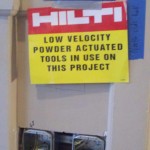
If you’re using these tools in construction please be careful.
Quick summary:
- the powder contains lead (Pb)
- you can be exposed to lead when it is airborne, AND if it gets on your hands & you eat it.
- lead is not healthy for kids
- Wash!
Tue 16 Oct 2012
Posted by admin under Lead
Comments Off on You pirates be careful out there…

Chinese made pirate costumes were seized due to high lead (Pb) being found in them. CNN reported that levels were 11x over the allowable level (100 parts per million) by the consumer safety products division. The NBC news video can be found here, and they reported 40x the limits.
Tue 5 Jun 2012
Posted by admin under Air Monitoring, Lead, Management, Respirators, ventilation
Comments Off on Lead exposures during HVAC soldering work
As you may know, sometimes tin knockers (aka sheetmetal workers) Â use sheet lead, or lead soldering, to make flashing on roof vents. Here is a picture of what these commonly look like (if there is (?) a common one).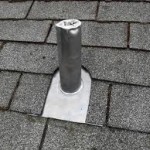
The lead iron is heated up. Lead solder, or sometimes lead/zinc solder is used. Muratic acid (or similar) is used to clean the stainless steel. The iron is used to heat up the solder and drip it on the stainless surface. Anyways, the process creates lead fumes. This is dangerous both from airborne inhalables to the contact surfaces surrounding the area.
The surfaces around these areas are usually very high in lead content. There is not a OSHA standard for lead wipe tests. However, in the past OSHA has used the HUD standards and cited employers under the general duty clause. If you are performing these tasks, please make sure you are doing everything you can to limit the airborne, dermal, and ingestion exposure.
- Follow OSHA Lead Standard (1926.62).
- Train your employees.
- Ventilation (downdraft is best). This is the best way to control the fumes.
- Post signs in the area “lead work and hazardous”.
- Perform air monitoring. I have found levels both above, and below, the exposure limits.
- Wear a respirator (1/2 face negative air with HEPA).
- Do not: eat, drink or smoke in this area.
- Good hygiene. Wash after doing these activities.
- Use a plastic sheeting on all surfaces. This makes it 100x easier to clean up.
in other words, don’t do what is in this picture below:
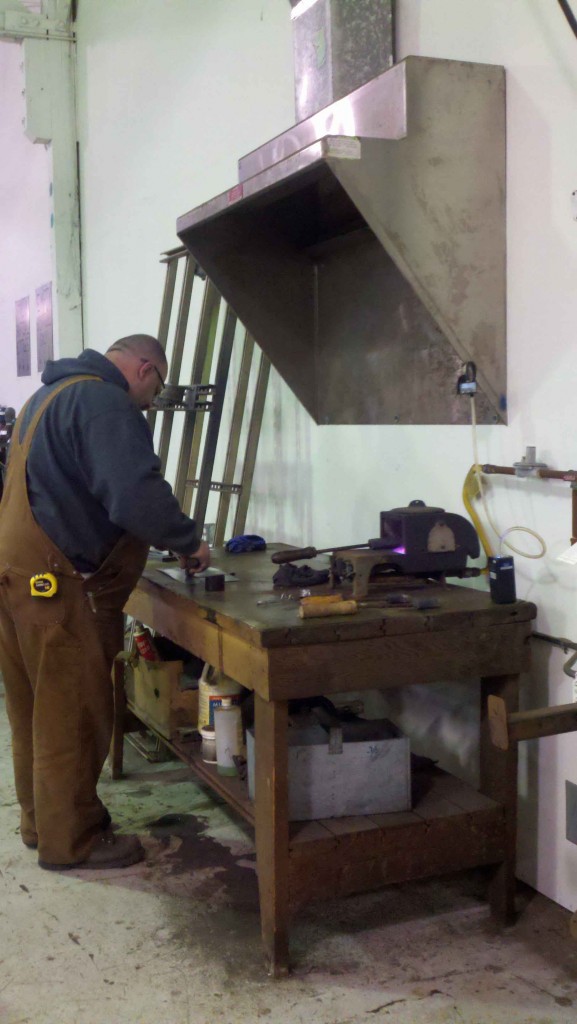
Fri 13 Apr 2012
Posted by admin under EPA, Lead, OSHA
[2] Comments
Who has jurisdiction over lead based paint? Are the EPA’s lead rules all I need to follow? Or, do I follow OSHA?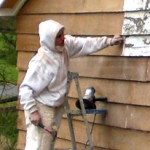
Well, the short answer (for those in construction) is YES. Usually OSHA, but maybe both EPA and OSHA (*and others, HUD, etc).
OSHA’s focus (as I’m sure you know) is to protect employees. If you are removing leaded on your own home, OSHA has no jurisdiction. However, if you have employees and are working with lead based paint, you must follow OSHA.
The EPA is focused on the environment (of course). They have implemented (April 22, 2008) a rule called the Renovation, Repair & Painting Rule. This rule applies when you are working on any facility which effects kids under the age of 6. If you are contractor looking to work on a project (s) with this demographic, you need to be certified by the EPA. Here is a good starting spot.
It is interesting (maybe just to me) but the EPA has very little enforcement, compared to OSHA. Yet, most people are very aware of the EPA rule. In contrast, I find contractors working with leaded paint who don’t know that they are under OSHA’s rules. I suppose the EPA has done a great job of marketing.
Another interesting comparison is that the EPA and OSHA rules are actually very similar. There are differences, but in general, if you are following the OSHA rules correctly, you are most likely very close to complying with the EPA. (one difference: the EPA requires certification)








